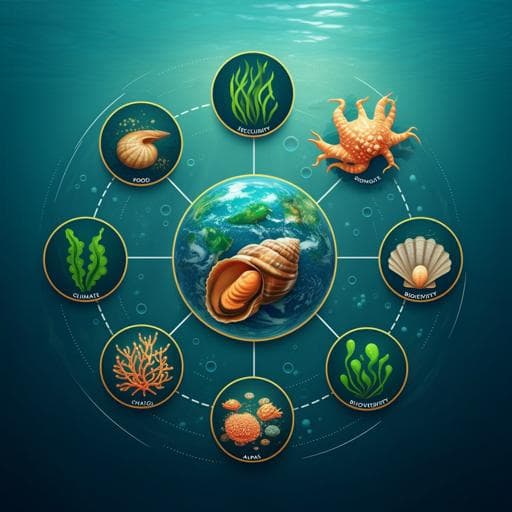
Environmental Studies and Forestry
A traits-based approach to assess aquaculture's contributions to food, climate change, and biodiversity goals
A. Wong, A. Y. Frommel, et al.
Discover how aquaculture can bolster food security and combat climate change while preserving biodiversity. This innovative study by Aleah Wong, Andrea Y. Frommel, U. Rashid Sumaila, and William W. L. Cheung reveals the key traits that contribute to these goals and highlights the potential of algae and mollusks in sustainable practices.
~3 min • Beginner • English
Introduction
The study addresses how aquaculture can contribute to the United Nations SDGs on food security (SDG 2), climate action (SDG 13), and life below water/biodiversity (SDG 14). Aquatic foods have become increasingly important for nutrition, livelihoods, and global food supply, yet aquaculture growth faces uncertainties due to climate change and biodiversity impacts. The authors aim to quantify aquaculture’s contribution potential to the food-climate-biodiversity (FCB) nexus by explicitly considering biological and ecological traits of farmed species linked to SDG targets and indicators. They frame food security potential around production of nutritious aquatic foods and resilient, sustainable productivity (SDG 2 targets/indicators), climate potential around resilience/adaptive capacity and integration of climate considerations in strategies (SDG 13), and biodiversity around reducing pollution, ecosystem-based management, and ending overfishing (SDG 14). The rationale is that traits influence domestication success and environmental outcomes; therefore, a trait-based, fuzzy logic approach can evaluate species’ potential across FCB goals, informing strategies and policy.
Literature Review
Prior research often assessed aquaculture performance for production using single taxa or traits (e.g., growth rate), neglecting broader FCB linkages and multi-trait interactions. Studies have shown traits influence distributions, invasiveness, sensitivity to fishing, and climate vulnerability, and have been used in aquaculture suitability and breeding contexts. However, explicit linkage of farmed species’ traits to the FCB nexus is limited. Through a systematic literature review (PRISMA-guided), the authors synthesized traits associated with food security, climate change (impacts and mitigation), and biodiversity, organizing them into themes such as Nutrition (macro- and micronutrient density), Production efficiency (growth rate, fecundity, maximum size), Environmental tolerance (ranges of nitrate, phosphate, temperature, salinity, dissolved oxygen, pH sensitivity), Feed efficiency (trophic level/fishmeal use), Invasiveness (fecundity, VBGF K, geographic/latitudinal range, aggression, spatial behavior), Climate change mitigation (carbon sequestration, ocean acidification buffering), Benefits to local biodiversity (bioremediation, structure-provisioning). Many traits overlapped across FCB dimensions, particularly with food security. This synthesis informed the fuzzy expert system’s rule base.
Methodology
The authors developed a trait-based fuzzy expert system to quantify each species’ potential contribution to food security, climate change, and biodiversity (FCB). Methods comprise: 1) Systematic literature review: A qualitative review following PRISMA identified biological and ecological traits of farmed species related to FCB, recording the trait, its F/C/B context, linkage rationale, and taxa references. Traits were grouped into FCB themes (Nutrition, Production efficiency, Environmental tolerance, Feed efficiency, Invasiveness, Climate change mitigation, Benefits to local biodiversity). 2) Trait data compilation: For 54 major aquaculture species (from FAO’s 2022 State of World Fisheries and Aquaculture; proxies used where needed), trait values were compiled primarily from FishBase and SeaLifeBase, with supplemental literature for missing data, and environmental thresholds from World Ocean Atlas 2018; occurrences from OBIS/GBIF; invertebrate nutrition from FAO/INFOODS. 3) Fuzzy logic framework: • Fuzzification: For each trait, four linguistic categories (low, medium, high, very high) were defined using trapezoidal (low, very high) and triangular (medium, high) membership functions. Thresholds were informed by literature and 25th/75th percentiles. Overlap allowed partial memberships; membership threshold for consideration was 0.2. Missing trait data were penalized by assigning to low potential. • Rule base and reasoning: Heuristic if-then rules linked trait fuzzy sets to F, C, or B potential levels, with equal rule weights (0.5) and a firing threshold of 0.2. Conclusions across traits were combined using the MYCIN accumulation algorithm to obtain accumulated membership in the four output categories (low, medium, high, very high) for each F, C, and B index. • Defuzzification: Accumulated memberships were converted to a 1–100 index using representative values (Low=1, Medium=25, High=75, Very high=100) and weighted averaging. 4) Case studies and analysis: The system was applied to 54 species spanning algae, molluscs, crustaceans, and finfish. Species’ absolute scores and non-parametric rankings were produced. Group comparisons used non-parametric tests (Kruskal–Wallis, with post-hoc Dunn’s tests) due to non-normal distributions. Rank-based associations between indices used Kendall’s tau. 5) Sensitivity analysis: Jackknife resampling assessed influence of each trait by removing one trait at a time (and up to n−1 traits), repeating 50 times to generate distributions of deviations from the baseline index. Traits causing larger deviations were considered more influential; asymmetrical bias directions were noted. Data and code availability: GitHub repository (aleahwong/aquaculture_FCB), with data sources cited (FAO, FishBase, SeaLifeBase, OBIS, GBIF, World Ocean Atlas).
Key Findings
- Trait associations: 60% of identified aquaculture traits were linked to food security; two-thirds of food-related traits also linked to climate change or biodiversity. About two-fifths and one-third of traits linked to climate change and biodiversity respectively, with less cross-over than food. - Score distributions: Across 54 species, mean scores were Food=50, Climate=46, Biodiversity=53 (on 1–100 scale). Food scores spanned ~30 points; climate and biodiversity ~40 points. Most species had intermediate scores. - Taxonomic patterns: Non-fed taxa scored higher across FCB. Algae and molluscs had significantly higher median food and biodiversity scores than finfish and crustaceans; algae had higher climate scores than molluscs. Crustaceans had significantly lower climate scores than other groups; finfish and molluscs did not differ significantly in median climate scores. Within-taxon variability was high among finfish and crustaceans. - Species-level highlights: Many commonly farmed finfish/crustaceans (e.g., gilthead seabream Sparus aurata and giant tiger prawn Penaeus monodon) were among the lowest across F, C, and B. Some finfish scored well in specific indices: bighead, silver, and common carp (Hypophthalmichthys nobilis, H. molitrix, Cyprinus carpio) ranked high for climate potential; flathead grey mullet (Mugil cephalus) and milkfish (Chanos chanos) ranked high for food potential. However, some of these had low biodiversity scores (e.g., carp, mullet). The only crustacean in the top 10 for biodiversity, Macrobrachium rosenbergii, was among the bottom for climate potential. - Top performers: Algae and molluscs dominated top biodiversity and climate lists. Algae species such as Porphyra yezoensis/tenera (nori/laver), Kappaphycus alvarezii (elkhorn sea moss), and Japanese kelp (Saccharina/Laminaria japonica) appeared in top 10 across all FCB categories. - Correlations among indices: Positive rank correlations observed due to overlapping traits: Food–Climate Kendall’s tau = 0.441 (p = 1.299e−06); Food–Biodiversity tau = 0.377 (p = 3.608e−05); Climate–Biodiversity tau = 0.283 (p = 0.00195). - Sensitivity (jackknife): • Food index most sensitive to maximum size, VBGF K, absolute fecundity, macronutrient density, nitrate and phosphate range. Removing macronutrients, nitrate, or phosphate produced negative asymmetrical bias; removing maximum size, VBGF K, or fecundity produced positive bias. Deviations exceeded 10–20% of max food index (61) for several traits. • Climate index most sensitive to nitrate, phosphate, salinity, pO2 ranges, pH sensitivity, and feed efficiency (trophic level). Removing nitrate caused >20% deviation; removing pH sensitivity caused >30% deviation of max climate index (66). Most removals caused negative bias except salinity (positive bias). • Biodiversity index most sensitive to VBGF K, absolute fecundity, geographic and latitudinal ranges; removals caused negative bias, with deviations >25% of max biodiversity index (68) for most of these traits. - Case comparison: Japanese kelp outperformed Atlantic salmon and Pacific oyster across all indices; Atlantic salmon had below-average biodiversity potential; Pacific oyster around average biodiversity and higher food than salmon. Rankings placed Japanese kelp in top half for all indices; salmon and oyster in bottom half for most. - Overall insight: Production-maximizing traits (fecundity, growth, size, trophic level) and environmental tolerance traits (nitrate/phosphate/pH tolerance, geographic/latitudinal ranges) strongly influence FCB potential. Algae and molluscs generally offer higher multi-goal potential than fed finfish/crustaceans.
Discussion
Findings indicate that aquaculture’s historical focus on maximizing production and macronutrient outputs is insufficient to advance SDG-aligned food security and may conflict with climate and biodiversity goals. Overlap and positive correlations among F, C, and B indices show intertwined opportunities for co-benefits but also reveal trade-offs: traits enhancing production (high fecundity, rapid growth) can increase invasiveness risk and reduce biodiversity potential. High-trophic fed species exacerbate feed-related environmental burdens and can undermine local food security where small pelagics are diverted to aquafeeds. Conversely, low-trophic taxa (algae, molluscs) tend to deliver broader FCB benefits, including nutrient provision (notably micronutrients), lower environmental footprints, potential eutrophication mitigation, and climate co-benefits. Integrated multi-trophic aquaculture (IMTA) and species selection based on inherent traits can increase FCB potential while mitigating trade-offs—e.g., co-culturing finfish with bivalves and seaweeds to utilize waste and reduce impacts. Trait-informed strategies (e.g., farming species in native ranges, prioritizing environmental tolerance and feed efficiency) and targeted breeding/technology (e.g., improving nutritional profiles, plant-based feeds) can enhance outcomes. Policymakers can leverage these insights to redirect incentives toward FCB-positive species and systems, recognizing socio-economic constraints and the need for context-specific transitions.
Conclusion
This study introduces a biologically informed, trait-based fuzzy logic framework to quantify the potential of aquaculture species to contribute to SDG targets on food security, climate change, and biodiversity. Applying the framework to 54 major species shows algae and molluscs generally have higher multi-goal potential than fed finfish and crustaceans, while key traits related to production and environmental tolerance largely shape outcomes. The results highlight co-benefits and trade-offs across FCB goals, demonstrating that production-centric strategies alone are inadequate. The approach guides species selection, system design (e.g., IMTA), and policy prioritization to accelerate FCB-positive aquaculture. Future research should integrate social-ecological traits, assess species across diverse production systems and environmental contexts, and address economic and governance barriers, particularly for emerging sectors like seaweed, to realize identified biological potential.
Limitations
- The fuzzy expert system estimates biological/ecological potential and does not explicitly incorporate extrinsic socio-economic and technological factors (e.g., regulations, markets, infrastructure), which influence realized outcomes. - Data gaps exist, particularly for non-fish species; missing traits were penalized as low potential, potentially biasing scores. - Use of proxies (e.g., trophic level as a feed efficiency proxy) and generalized trait thresholds may oversimplify species- and context-specific nuances. - The model assumes literature-informed rule weights and membership functions; while sensitivity analyses were performed, assumptions can affect results. - Potential invasiveness and biodiversity impacts depend strongly on local context (native vs non-native ranges, open vs closed systems), not fully captured by trait proxies. - Economic and market limitations (e.g., seaweed oversupply in Asia, limited North American markets, leasing/regulatory barriers) may constrain implementation of recommended shifts. - Nutritional potential considers macro- and micronutrients, but consumer access, cultural preferences, and distributional factors were not directly modeled.
Related Publications
Explore these studies to deepen your understanding of the subject.







